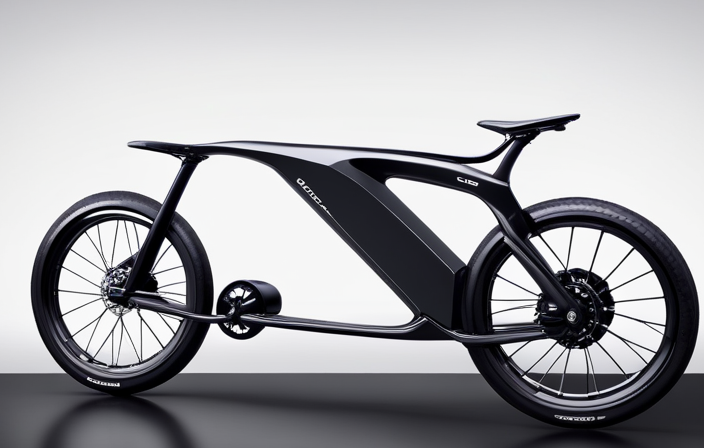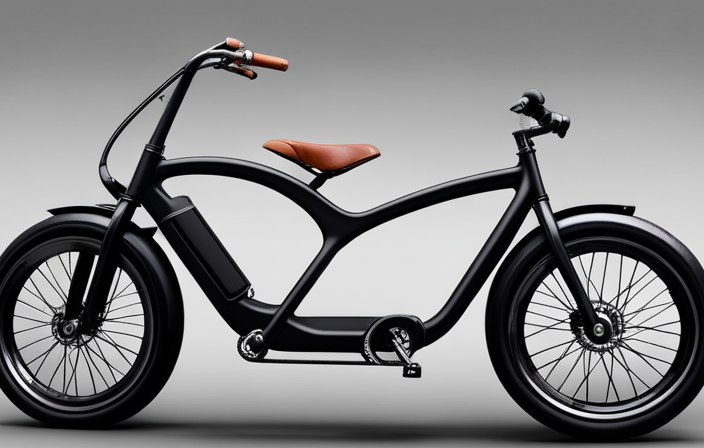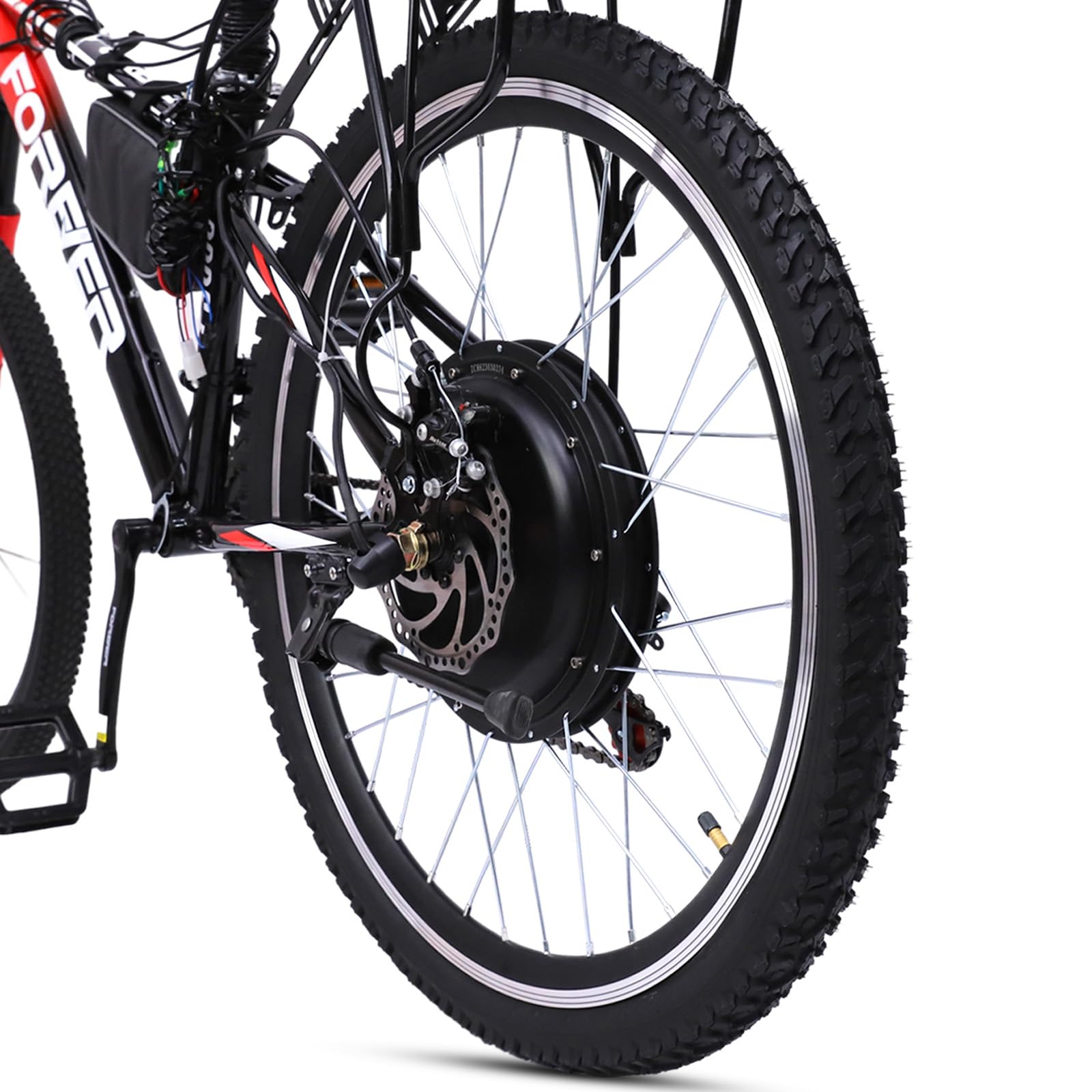Electric Bike
How Long Does A Battery Last On An Electric Bike

Have you ever pondered the durability of an electric bike battery, the crucial power supply that allows for a seamless ride?
In this article, we will delve into the intricacies of battery life on an electric bike. From the impact of battery capacity and technology to the influence of riding conditions, we’ll explore every facet of this vital component.
Additionally, we’ll provide valuable tips to extend battery life and discuss future trends in electric bike batteries.
So, let’s dive in and uncover the secrets of maximizing your battery’s lifespan!
Key Takeaways
- Electric bike batteries, such as lithium-ion and solid-state batteries, have longer lifespans compared to traditional batteries.
- Advances in electric bike battery technology, such as increased energy density and faster charging capabilities, contribute to a more sustainable industry.
- Utilizing warranty and support options for electric bike batteries is crucial for optimal performance and resolving technical difficulties.
- Following tips for extending battery life, such as riding in pedal-assist mode and avoiding extreme temperatures, significantly increases the lifespan of the battery.
Battery Capacity and Range
The battery’s capacity determines how far an electric bike can go on a single charge. Battery efficiency and management play crucial roles in maximizing the range.
Battery efficiency refers to how well the battery can convert stored energy into usable power. It depends on factors such as the battery chemistry, temperature, and overall design. Battery management systems (BMS) ensure optimal performance and longevity by monitoring the battery’s condition, balancing cell voltages, and preventing overcharging or discharging. A well-designed BMS can significantly improve the battery’s efficiency and extend its lifespan.
However, it’s important to note that the battery’s capacity is just one aspect of the equation. Other factors like terrain, rider weight, and speed also affect the range.
Transitioning into the next section, battery type and technology further impact the overall performance and lifespan of the battery.
Battery Type and Technology
Choose the right type and technology for your e-bike battery to maximize its lifespan. When it comes to battery efficiency, the type and chemistry of the battery play a crucial role. Here are four key factors to consider:
-
Lithium-ion batteries: These are the most common type for e-bikes due to their high energy density and long lifespan.
-
Battery chemistry: Different chemistries, such as lithium iron phosphate (LiFePO4) or lithium cobalt oxide (LiCoO2), offer varying trade-offs between energy density, lifespan, and cost.
-
Cell balancing: Opt for batteries with a built-in cell balancing system to ensure each cell is charged and discharged equally, maximizing overall battery performance.
-
Battery management system (BMS): A BMS helps monitor and control the battery’s state, preventing overcharging or deep discharging, which can negatively impact the battery’s lifespan.
Understanding these factors will help you choose the right battery type and technology for your e-bike, ensuring optimal battery performance.
Moving on to charging and maintenance, let’s explore how to keep your e-bike battery in top condition.
Charging and Maintenance
To ensure optimal performance, it’s important to properly charge and maintain your e-bike battery. When it comes to charging techniques, it’s crucial to follow the manufacturer’s recommendations.
Most e-bike batteries can be charged using a standard wall outlet, but some may require a specific charger. It’s important to avoid overcharging your battery, as this can lead to decreased battery life and performance. Additionally, it’s recommended to charge your battery at room temperature to prevent overheating.
Battery care is equally important in maintaining the longevity of your battery. Regularly clean the battery and connections with a damp cloth to remove any dirt or debris. It’s also advisable to store your battery in a cool, dry place when not in use.
By following these charging techniques and practicing proper battery care, you can ensure your e-bike battery lasts longer and performs at its best.
Now, let’s move on to discussing how riding conditions can affect battery life.
Riding Conditions
When it comes to electric bike battery performance, riding conditions play a crucial role. Temperature and weather can have a significant impact on how long your battery lasts.
Cold temperatures, for example, can cause the battery to lose capacity and reduce its overall range.
Additionally, adjusting your riding style can help optimize battery usage. Smooth acceleration, avoiding unnecessary braking, and maintaining a steady speed can all contribute to maximizing your electric bike’s battery life.
How riding conditions, such as temperature and weather, can impact battery performance
Riding conditions, such as temperature and weather, can significantly impact the performance of an electric bike’s battery. Firstly, elevation plays a crucial role in battery efficiency. When riding uphill, the battery has to work harder to propel the bike, resulting in a faster drain. On the other hand, going downhill can recharge the battery slightly due to regenerative braking.
Secondly, wind resistance also affects battery usage. Riding against strong headwinds increases the drag on the bike, requiring more power from the battery to maintain speed. Conversely, riding with tailwinds reduces the resistance, thus conserving battery power.
It is important to note that extreme temperatures, both hot and cold, can decrease battery efficiency. To optimize battery usage, adjusting your riding style by avoiding steep inclines and strong headwinds can help prolong battery life.
Next, let’s explore how adjusting your riding style can further optimize battery usage.
Adjusting your riding style to optimize battery usage
By adjusting your riding style, you can optimize how efficiently the battery is used. Riding techniques play a crucial role in conserving energy and extending the battery life of your electric bike. Here are some key techniques to consider:
-
Smooth Acceleration and Deceleration: Gradually increase speed and avoid sudden stops to minimize energy consumption.
-
Pedal Assist: Utilize the pedal assist feature to share the workload with the motor, reducing battery usage.
-
Efficient Gear Shifting: Shift to lower gears when climbing hills to maintain a steady cadence and reduce motor strain.
-
Aerodynamic Position: Maintain a streamlined position by tucking in your elbows and lowering your body, reducing wind resistance and energy expenditure.
Implementing these riding techniques will help you optimize battery usage and maximize your electric bike’s range. By conserving energy through efficient riding, you can enhance the overall battery life expectancy. Moving forward, let’s explore the factors that affect battery life expectancy.
Battery Life Expectancy
To get the most out of your electric bike, you’ll want to know how long the battery typically lasts. The battery life expectancy can vary depending on several factors, including the battery charging methods and battery storage solutions used. Here are four key points to consider:
-
Charging method: Using the recommended charger and following proper charging practices can help extend the battery life. Avoid overcharging or completely draining the battery.
-
Storage solutions: Storing the battery in a cool, dry place when not in use can help preserve its lifespan. Extreme temperatures and moisture can have a negative impact on battery performance.
-
Battery capacity: The capacity of the battery, usually measured in watt-hours (Wh), can affect its lifespan. Higher capacity batteries generally last longer before needing to be replaced.
-
Usage patterns: How you ride and the terrain you tackle can influence battery life. Riding at higher speeds, climbing steep hills, and using the highest power assist levels will drain the battery faster.
Understanding these factors can help you optimize your battery usage and prolong its lifespan.
Now, let’s delve into the topic of battery replacement and recycling.
Battery Replacement and Recycling
Battery replacement and recycling are important considerations when it comes to the overall lifespan of an electric bike battery. Eventually, your battery will reach the end of its life and will need to be replaced. When this happens, it’s crucial to dispose of the old battery properly to minimize its environmental impact.
Many manufacturers and retailers offer battery recycling programs, allowing you to safely and responsibly dispose of your old battery. This ensures that the battery components, such as lithium-ion cells, are recycled and reused, reducing the need for new raw materials. By participating in these programs, you can contribute to the sustainability of electric bike batteries. Moreover, battery recycling also helps to prevent the release of harmful substances into the environment.
Now, let’s explore the next section on battery warranty and support to understand how you can ensure the longevity of your electric bike battery.
Battery Warranty and Support
Make sure you take advantage of the warranty and support options available for your electric bike’s battery. The battery warranty is a crucial aspect to consider when purchasing an electric bike. It provides you with peace of mind and financial protection should any issues arise with your battery.
Many manufacturers offer warranties ranging from 1 to 3 years, ensuring that you are covered in case of any defects or malfunctions. Additionally, battery support is essential for troubleshooting and resolving any technical difficulties you may encounter. Manufacturers often provide customer service and technical support to assist you in resolving any battery-related problems. This support can include phone or email assistance, online resources such as FAQs and user manuals, and even repair or replacement services.
By taking advantage of these warranty and support options, you can ensure your electric bike’s battery performs optimally for an extended period.
In the next section, we will provide tips for extending your battery life without compromising performance.
Tips for Extending Battery Life
Maximize the lifespan of your e-bike’s battery by implementing these helpful tips.
Extending battery range and maximizing battery efficiency are crucial for getting the most out of your electric bike. One of the key ways to extend battery range is to ride in the pedal-assist mode instead of relying solely on throttle power. This helps to conserve battery energy and allows you to cover longer distances.
Additionally, maintaining proper tire pressure and reducing wind resistance by riding at a consistent speed can also help to extend battery life. Another important tip is to avoid extreme temperatures, as both extreme cold and heat can negatively impact battery performance.
Finally, make sure to charge your battery properly and avoid overcharging. By following these tips, you can significantly increase the lifespan of your e-bike’s battery.
Transitioning into the next section about battery upgrades and accessories, let’s explore how these enhancements can further enhance your e-bike experience.
Battery Upgrades and Accessories
To enhance your e-bike experience, consider upgrading your battery or adding accessories. Upgrading your battery can significantly improve battery storage and efficiency. Here are four options to consider:
-
High-capacity battery: Upgrade to a higher capacity battery to increase your e-bike’s range. A larger battery can store more energy, allowing you to ride longer distances without recharging.
-
Smart battery management system: Invest in a smart battery management system that optimizes battery usage. These systems monitor and regulate battery performance, ensuring maximum efficiency and prolonging battery life.
-
Lightweight battery: Replace your current battery with a lightweight option. Lighter batteries reduce the overall weight of your e-bike, making it easier to handle and improving overall performance.
-
Battery accessories: Consider adding accessories like a battery bag or case. These accessories provide extra protection and insulation for your battery, keeping it safe from extreme temperatures and extending its lifespan.
By upgrading your battery or adding accessories, you can maximize your e-bike’s battery storage and efficiency.
Looking ahead, let’s explore future trends in electric bike batteries.
Future Trends in Electric Bike Batteries
Consider exploring the future trends in e-bike batteries to stay up to date with the latest advancements and innovations. Electric bike battery technology is constantly evolving, and staying informed will ensure that you make the most informed decisions when it comes to your e-bike battery. Here are some current advancements in electric bike batteries that are shaping the future of the industry.
| Advancements | Impact on Sustainability |
|---|---|
| Lithium-ion batteries | Longer lifespan, increased energy density, and faster charging capabilities. These advancements contribute to a more sustainable electric bike industry by reducing the need for frequent battery replacements and minimizing the environmental impact of battery disposal. |
| Solid-state batteries | These batteries offer higher energy density, improved safety, and longer lifespan. They have the potential to revolutionize the electric bike industry, making e-bikes more efficient and environmentally friendly. Solid-state batteries are also expected to be more sustainable due to the absence of toxic materials commonly found in traditional lithium-ion batteries. |
| Wireless charging | This technology eliminates the need for physical connections between the charger and the battery. It simplifies the charging process and reduces wear and tear on the battery, ultimately extending its lifespan. Wireless charging also reduces the environmental impact of e-bike batteries by eliminating the need for disposable charging cables. |
By keeping up with these advancements, you can ensure that you are making sustainable choices for your electric bike battery while enjoying the benefits of improved technology.
Frequently Asked Questions
Can I use any type of battery for my electric bike?
You can’t use any type of battery for your electric bike. Battery compatibility is crucial for optimal performance. Different batteries have varying capacities, voltages, and chemistries that directly affect battery performance and overall efficiency.
What are the factors that can affect the battery life of an electric bike?
Battery life on an electric bike is influenced by various factors. Proper battery maintenance, such as avoiding extreme temperatures and unnecessary deep discharges, is crucial. Additionally, implementing efficient battery charging techniques, like avoiding overcharging and using the correct charger, can significantly extend its lifespan.
Is it possible to upgrade the battery capacity of my electric bike?
Upgrading the battery voltage of your electric bike can significantly enhance its performance, like a sports car with a turbocharger. A higher capacity battery will provide increased range, improved acceleration, and the ability to tackle steeper inclines, enhancing your overall riding experience.
How do I properly dispose of or recycle an old electric bike battery?
To properly dispose of or recycle an old electric bike battery, you must follow specific guidelines. Start by researching local recycling options or contacting the manufacturer for information on proper disposal methods.
Are there any safety precautions I should take while charging my electric bike battery?
When charging your electric bike battery, it is essential to follow safety precautions to ensure optimal performance and longevity. Properly maintain your battery by following recommended charging times and storage guidelines for maximum efficiency and safety.
Conclusion
Congratulations on reaching the end of this detailed and analytical article!
Now that you are well-informed about electric bike batteries, you can make informed decisions about your battery’s lifespan and performance.
By understanding factors such as battery capacity, type, charging habits, and riding conditions, you can extend your battery’s life and maximize its efficiency.
Additionally, keeping an eye on battery upgrades and accessories can ensure that you stay ahead of future trends in electric bike batteries.
So, go ahead and enjoy your electric bike knowing that you have the knowledge to keep your battery running smoothly for years to come.
Olivia’s writing is not only informative but also inspiring. She has a knack for telling stories that capture the essence of cycling and the joy it brings to people’s lives. Her writing has been praised by readers and industry experts alike for its clarity, depth, and authenticity.
In addition to her writing, Olivia is also an avid cyclist. She enjoys exploring new trails and routes and has participated in several cycling events and races. Her first-hand experience with cycling gives her a unique perspective on the sport, reflected in her writing.
Overall, Olivia is a talented writer passionate about cycling and dedicated to producing high-quality content for FlatironBike. Her contributions to the magazine have helped make it a go-to source for cycling enthusiasts worldwide.
Electric Bike
What Size Motor Gor An Electric Bike
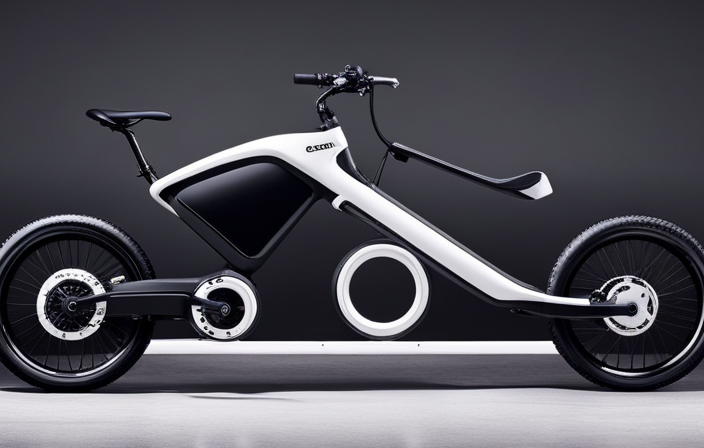
Interested in purchasing an electric bike but unsure about which motor size to choose? It can be overwhelming with numerous options available, but don’t fret – we are here to help.
In this article, we’ll guide you through the process of understanding electric bike motors and help you determine the perfect size for your riding needs.
So, let’s dive in and find out what size motor is best suited for you.
Key Takeaways
- Accurate calculations are important for selecting the right motor size for an electric bike, considering factors like rider weight, terrain, and usage.
- Testing different motor sizes is crucial to determine the optimal performance, including speed, acceleration, and range.
- Budget considerations should be taken into account when choosing a motor size, balancing performance and affordability.
- There is a direct correlation between motor size and cost, with larger motors generally being more expensive but providing more power and speed.
Understanding Electric Bike Motors
Now, let’s talk about what size motor you’ll need for your electric bike. The size of the motor is crucial in determining the performance and capabilities of your electric bike. It is directly linked to the power output and speed that the bike can achieve.
When choosing the motor size, you need to consider several factors such as the terrain you’ll be riding on, your weight, and your desired speed. In general, a larger motor will provide more power and higher speeds, making it suitable for hilly terrains or if you want to ride at high speeds.
On the other hand, a smaller motor may be more suitable for flat terrains and for riders who prioritize energy efficiency and longer battery life. Determining your riding needs will help you select the appropriate motor size for your electric bike.
Determining Your Riding Needs
To figure out what kind of motor you need for your e-bike, start by determining how you plan to use it. Consider the following factors:
- Terrain: Will you be riding mostly on flat surfaces or tackling steep hills?
- Distance: How far do you plan to ride on a single charge?
- Speed: Do you want to reach high speeds or prefer a more leisurely pace?
- Load: Will you be carrying heavy cargo or just yourself?
By understanding your riding needs, you can choose the right motor size that meets your requirements.
Now, let’s explore the benefits of a small motor.
Benefits of a Small Motor
By choosing a smaller motor, you’ll experience increased maneuverability and greater efficiency.
A smaller motor allows for easier handling and navigation, especially in tight spaces or crowded areas. It gives you the ability to make sharp turns and navigate through traffic with ease.
Additionally, a smaller motor requires less power, resulting in greater efficiency and longer battery life. You’ll be able to cover longer distances on a single charge, making it ideal for commuters or those who enjoy longer rides.
Moreover, a smaller motor reduces the overall weight of the electric bike, making it easier to transport or store when not in use. This compact size also allows for a sleeker and more streamlined design, enhancing the aesthetics of your electric bike.
Now, let’s explore the benefits of a medium motor.
Benefits of a Medium Motor
If you opt for a medium-sized motor, you’ll enjoy a balance between maneuverability and power. The medium motor offers several advantages that make it a popular choice among electric bike enthusiasts.
- The medium-sized motor provides sufficient power to tackle hilly terrains without compromising on the bike’s agility.
- It offers a smooth and responsive ride, allowing you to accelerate quickly and maintain a steady pace.
- The medium motor is efficient, ensuring optimal battery usage and extending your riding range.
With a medium-sized motor, you’ll experience the best of both worlds – the ability to navigate through tight spaces and the power to conquer challenging routes.
However, if you’re seeking even more power, let’s explore the benefits of a large motor. A larger motor can provide enhanced performance and take your electric bike adventures to the next level.
Benefits of a Large Motor
With a larger motor, you’ll experience a significant boost in performance, taking your electric bike adventures to new heights. A large motor provides more power, allowing you to tackle challenging terrains and achieve higher speeds effortlessly. Let’s take a look at the benefits of upgrading to a larger motor:
| Benefits | Description |
|---|---|
| Increased Speed | A larger motor enables your electric bike to reach higher speeds, making your rides more thrilling and exciting. |
| Improved Torque | With increased torque, you can effortlessly climb steep hills and navigate rough terrain with ease. |
| Enhanced Range | The larger motor provides more power, extending your electric bike’s battery life and allowing for longer rides. |
| Better Acceleration | Experience quicker acceleration, allowing you to keep up with traffic and have a more dynamic riding experience. |
Considering Motor Placement
When deciding where to place the motor, you’ll want to consider factors such as weight distribution and accessibility. Proper motor placement is crucial for the overall performance and handling of your electric bike.
To achieve optimal weight distribution, the motor should be positioned towards the center of the bike frame. This ensures better stability, especially when navigating corners or uneven terrain.
Additionally, accessibility is important for maintenance and repairs. Placing the motor in a location that allows easy access will save you time and effort in case you need to address any issues.
Now that you have considered motor placement, let’s move on to another important aspect of building your electric bike: battery capacity and range.
Battery Capacity and Range
Now that you’ve decided on the placement of the motor, it’s important to consider the battery capacity and range for your electric bike.
The battery is the lifeblood of your electric bike, providing the power needed to propel you forward. The capacity of the battery is measured in ampere-hours (Ah), which determines how much energy it can store. A higher capacity battery will allow for a longer range, meaning you can travel further on a single charge.
It’s crucial to assess your specific needs and usage patterns to determine the appropriate battery capacity for your bike. Keep in mind that factors such as terrain, rider weight, and riding style can also affect the range of your electric bike.
Consultation and Test Rides
When it comes to choosing the right motor size for your electric bike, seeking expert advice can be crucial. Consulting with professionals who have extensive knowledge and experience in the field can help you make an informed decision based on your specific needs and preferences.
Additionally, trying out different motor sizes through test rides can give you a hands-on experience and a better understanding of how each size performs, allowing you to make a more accurate assessment of which one suits you best.
Seeking Expert Advice
If you’re looking for expert advice on the size of motor for an electric bike, you should consult with a professional in the field. They can provide you with valuable insights and recommendations based on their knowledge and experience. Here are three reasons why seeking expert advice is crucial:
-
Accurate calculations: A professional can accurately calculate the power and torque requirements of your electric bike, taking into account factors such as rider weight, terrain, and intended usage.
-
Optimal performance: By choosing the right motor size, you can ensure that your electric bike performs optimally in terms of speed, acceleration, and range.
-
Safety considerations: Experts can guide you in selecting a motor size that matches your skill level and ensures the safety of both you and other road users.
Trying Different Motor Sizes
After consulting with a professional, it’s important to test out various motor options to find the best fit for your needs. The size of the motor you choose will greatly impact the performance and efficiency of your electric bike. To help you make an informed decision, consider the following table that outlines the different motor sizes and their corresponding characteristics:
| Motor Size | Power Output | Acceleration | Top Speed |
|---|---|---|---|
| Small | Moderate | Average | Limited |
| Medium | High | Quick | Decent |
| Large | Very high | Rapid | Impressive |
Budget Considerations
When considering the cost differences between motor sizes for electric bikes, you need to carefully balance performance and affordability.
Choosing a larger motor may provide more power and speed, but it can also come with a higher price tag.
On the other hand, opting for a smaller motor may be more budget-friendly, but it could limit the bike’s overall performance capabilities.
It’s important to assess your specific needs and budget constraints to find the right balance between motor size, performance, and affordability.
Cost Differences Between Motor Sizes
You can save money by opting for a smaller motor size for your electric bike. When it comes to the cost of electric bike motors, there is a direct correlation between size and price. Smaller motors are generally more affordable compared to their larger counterparts. This is because smaller motors require less material and components, resulting in lower manufacturing costs.
Additionally, smaller motors often have lower power outputs, which can also contribute to their lower price tags. However, it is important to consider your specific needs and preferences when choosing a motor size. While a smaller motor may be more cost-effective, it may not provide the same level of performance and acceleration as a larger motor.
Therefore, it is crucial to find the right balance between performance and affordability to ensure that you get the most out of your electric bike without breaking the bank.
Balancing Performance and Affordability
Finding the right balance between performance and affordability is crucial when choosing the ideal motor for your electric bike. To help you make an informed decision, consider the following factors:
-
Power output: A higher power motor will provide greater acceleration and top speed, but it may come at a higher cost.
-
Battery efficiency: Look for a motor that maximizes the efficiency of your battery, allowing for longer rides without draining power too quickly.
-
Weight: Consider the weight of the motor as it will affect the overall weight and maneuverability of your bike.
-
Noise level: Some motors can be noisier than others, so if noise is a concern for you, opt for a quieter motor.
-
Maintenance: Research the maintenance requirements of different motors to ensure you choose one that is easy to maintain and doesn’t require frequent servicing.
Making an Informed Decision
When choosing the right motor for your electric bike, it’s crucial to consider various factors. One of the most important factors is motor size. However, it’s equally important to weigh motor size with other factors such as power output, battery capacity, and the type of terrain you will be riding on.
Weighing Motor Size with Other Factors
It’s important to consider other factors when weighing the size of the motor for an electric bike. While the motor size does play a significant role in determining the bike’s performance, there are additional aspects that need to be taken into account.
Firstly, you should consider the terrain you will be riding on. If you plan on tackling steep hills or rough terrains, a more powerful motor would be necessary.
Additionally, the weight of the rider and any cargo should be considered. Heavier riders or those carrying extra load may require a larger motor to ensure optimal performance.
Lastly, the desired range or distance you want to travel on a single charge should be factored in.
Once these considerations are made, you can proceed to choose the right motor for your electric bike, taking into account all the relevant factors.
Choosing the Right Motor for Your Electric Bike
Considering the terrain, weight, and desired range are all important factors to consider when choosing the right motor for your e-bike.
The terrain you plan to ride on plays a crucial role in determining the motor size. If you’re mainly riding on flat surfaces, a smaller motor may be sufficient. However, if you’ll be tackling steep hills or off-road trails, a more powerful motor will be necessary.
Weight is another key consideration. If you’re a heavier rider or plan to carry heavy loads, a larger motor will provide the necessary torque to handle the extra weight.
Lastly, the desired range of your e-bike will also influence the motor choice. If you need to cover long distances, a motor with higher wattage and a larger battery capacity will be ideal.
Ultimately, selecting the right motor involves carefully analyzing these factors to ensure optimal performance and efficiency for your specific needs.
Conclusion
In conclusion, when choosing the size of the motor for your electric bike, it is crucial to consider your specific riding needs.
A small motor, like a hummingbird’s wings, offers agility and efficiency for urban commutes.
A medium motor, akin to a cheetah’s stride, provides a balance between power and maneuverability for diverse terrains.
Lastly, a large motor, resembling an eagle’s soar, delivers superior strength and speed for off-road adventures.
By carefully evaluating battery capacity, range, and budget, you can make an informed decision that ensures a thrilling and reliable electric biking experience.
Olivia’s writing is not only informative but also inspiring. She has a knack for telling stories that capture the essence of cycling and the joy it brings to people’s lives. Her writing has been praised by readers and industry experts alike for its clarity, depth, and authenticity.
In addition to her writing, Olivia is also an avid cyclist. She enjoys exploring new trails and routes and has participated in several cycling events and races. Her first-hand experience with cycling gives her a unique perspective on the sport, reflected in her writing.
Overall, Olivia is a talented writer passionate about cycling and dedicated to producing high-quality content for FlatironBike. Her contributions to the magazine have helped make it a go-to source for cycling enthusiasts worldwide.
Electric Bike
What Size Is 2012 Honda Dirt Bike With Electric Start

I understand your thoughts – why does the size of a 2012 Honda dirt bike with electric start matter to me? Let me explain, this detail is essential for individuals who are interested in buying a dirt bike that suits them best.
In this article, I will provide you with all the details you need to know about the overall dimensions, seat height, ground clearance, wheelbase, curb weight, brakes, tires, electric start feature, and available colors of this particular model.
So, buckle up and get ready to explore the world of dirt biking!
Key Takeaways
- The 2012 Honda dirt bike with electric start is compact in size and lightweight, providing effective maneuverability in tight corners and turns.
- It offers an adjustable seat and different seat heights, catering to riders of different heights and enhancing comfort during long rides.
- The bike has varying ground clearance measurements, allowing it to tackle different types of terrain and maintain traction, maneuverability, and stability.
- With a longer wheelbase, the 2012 Honda dirt bike provides improved stability, control, and traction, making it suitable for higher speeds and offering a more comfortable ride with better absorption of bumps and vibrations.
Overall Dimensions
The overall dimensions of the 2012 Honda dirt bike with electric start are convenient for maneuvering on various terrains. The bike has a compact size and a lightweight design, making it easy to handle and control. The weight distribution is well-balanced, ensuring stability and control while riding. This allows the bike to effectively navigate through tight corners and turns, even on rough terrains. Additionally, the turning radius of the bike is impressive, allowing for quick and precise maneuvers.
With its compact size and excellent weight distribution, the 2012 Honda dirt bike with electric start is designed to provide optimal performance and maneuverability.
Moving on to the next topic, the seat height of the bike is also worth mentioning.
Seat Height
With an electric start, the 2012 Honda dirt bike has a seat height that varies depending on the model. The adjustable seat allows riders to customize their comfort level, ensuring an optimal riding experience. The table below provides an overview of the seat heights for different models of the 2012 Honda dirt bike:
| Model | Seat Height (inches) |
|---|---|
| CRF250R | 37.6 |
| CRF450R | 37.8 |
| CRF150R | 34.1 |
| CRF230F | 34.6 |
| CRF70F | 26.1 |
Having an adjustable seat not only caters to riders of different heights but also enhances the overall comfort level. The ability to find the perfect seat height ensures a more ergonomic riding position, reducing strain on the body during long rides. Now, let’s move on to discussing the ground clearance of the 2012 Honda dirt bike.
Ground Clearance
Featuring varying ground clearance measurements, the 2012 Honda dirt bike models offer riders the flexibility to navigate different types of terrain. Ground clearance is an important factor in off-roading as it determines how high the bike sits off the ground. A higher ground clearance allows the bike to tackle obstacles such as rocks, logs, and uneven surfaces without getting stuck or damaged. On the other hand, a lower ground clearance may provide better stability and handling on smoother terrains.
The ground clearance affects the bike’s performance by impacting its ability to maintain traction, maneuverability, and stability. For example, a bike with more ground clearance may be able to handle deep mud or sand better than one with less clearance. With the right ground clearance, riders can confidently conquer various terrains, from trails and hills to rocky and sandy surfaces.
Transitioning to the subsequent section about ‘wheelbase,’ let’s now discuss how this aspect affects the overall performance of the bike.
Wheelbase
Having a longer wheelbase provides more stability and control when riding off-road. A longer wheelbase means that the distance between the front and rear wheels is increased, resulting in a more balanced and planted ride. This can be especially beneficial when navigating rough terrain or going over obstacles.
Some advantages of a longer wheelbase include:
- Improved stability: A longer wheelbase helps to distribute weight more evenly, making the bike less prone to tipping or losing control.
- Enhanced control: With a longer wheelbase, riders have better control over the bike, allowing for smoother turns and maneuvers.
- Increased traction: The added stability of a longer wheelbase can improve traction, especially on loose or slippery surfaces.
- Better handling at higher speeds: A longer wheelbase can provide a more stable platform for higher speed riding, reducing the chances of wobbling or losing control.
- Improved comfort: A longer wheelbase can result in a more comfortable ride, as it helps to absorb bumps and vibrations.
However, there are also some disadvantages to consider:
- Reduced maneuverability: A longer wheelbase can make the bike harder to maneuver in tight spaces or when making sharp turns.
- Increased difficulty in tight corners: Due to the longer length, it may be more challenging to navigate tight corners, requiring more space and planning.
- Potential for increased weight: A longer wheelbase can result in a heavier bike, which can make it more challenging to handle in certain situations.
Transitioning into the subsequent section about ‘curb weight’, it is important to consider not only the wheelbase but also the overall weight of the bike when determining its off-road capabilities.
Curb Weight
When it comes to off-road riding, you’ll want to consider the curb weight of your motorcycle. The curb weight refers to the total weight of the motorcycle with all necessary fluids and a full tank of fuel. It plays a crucial role in determining the bike’s maneuverability, stability, and overall performance on different terrains. To give you a better understanding of how curb weights can vary across different models, let’s take a look at the following curb weight comparison table:
| Model | Curb Weight (lbs) | Weight Distribution |
|---|---|---|
| Honda CRF250X | 254 | 47% Front, 53% Rear |
| Yamaha WR250F | 262 | 48% Front, 52% Rear |
| KTM 350 EXC-F | 242 | 45% Front, 55% Rear |
| Suzuki DR-Z400S | 317 | 49% Front, 51% Rear |
| Kawasaki KLX450R | 289 | 46% Front, 54% Rear |
Analyzing the weight distribution is also important as it affects how the bike handles in different conditions. With this curb weight comparison and weight distribution analysis in mind, we can now transition into the next section about fuel capacity.
Fuel Capacity
The fuel capacity of a motorcycle is an important factor to consider for long rides and off-road adventures. When it comes to fuel efficiency, a larger fuel capacity can be beneficial as it allows for longer distances between refueling stops. This is especially useful during off-road rides where gas stations may be scarce. Additionally, having a larger fuel tank means fewer stops for maintenance, as you won’t have to worry about refueling as frequently.
However, it is important to note that a larger fuel tank does add weight to the motorcycle, which may affect its handling and maneuverability. Therefore, it is crucial to find a balance between fuel capacity and other factors such as weight and size.
Speaking of size, another important consideration when choosing a motorcycle is the engine size.
Engine Size
One thing to consider when choosing a motorcycle is how the engine size affects its performance. The engine size, measured in cubic centimeters (cc), plays a crucial role in determining the power and fuel efficiency of a motorcycle.
Here are four key points to understand about engine size:
-
Engine Power: A larger engine size generally translates to greater power output. More cubic centimeters means more fuel combustion, resulting in increased horsepower and acceleration.
-
Torque: Engine size also impacts the torque, or rotational force, produced by the motorcycle. A larger engine size typically leads to higher torque, allowing for better performance at low speeds and smoother acceleration.
-
Fuel Efficiency: On the other hand, smaller engine sizes tend to offer better fuel efficiency. With less fuel consumption, these motorcycles can go longer distances on a single tank.
-
Handling and Maneuverability: Smaller engine sizes often result in lighter motorcycles, making them easier to handle and maneuver, especially in tight spaces and corners.
Understanding the relationship between engine size, power, and fuel efficiency is essential when choosing the right motorcycle for your needs.
Next, let’s delve into the concept of horsepower and how it relates to engine performance.
Horsepower
Understanding how engine size affects a motorcycle’s performance is crucial. One key factor to consider is horsepower, which measures the engine’s ability to produce power.
When it comes to electric start benefits, one advantage is the convenience it offers. With just a push of a button, the engine comes to life, eliminating the need for kick starting. This is especially beneficial for riders who may have difficulty kick starting a motorcycle or for those who want a hassle-free experience. However, it’s worth noting that some riders prefer the old-school kick start method for its simplicity and reliability.
Transitioning into the topic of torque, another essential factor in a motorcycle’s performance, let’s delve into how it complements horsepower to provide a well-rounded riding experience.
Torque
To fully appreciate the power of torque, you need to experience the exhilarating acceleration it provides when you twist the throttle on a motorcycle. Torque is the force that gets a motorcycle moving and determines its ability to accelerate. Unlike horsepower, which is a measure of overall power, torque specifically measures the twisting force an engine can generate.
Electric start benefits motorcycles by providing a convenient and reliable way to start the engine. Electric start eliminates the need for kick-starting, making it easier for riders of all skill levels to start their bikes.
When comparing torque to horsepower, it’s important to understand that torque is what gets you moving, while horsepower is what keeps you going at high speeds. With its immediate and powerful acceleration, torque is what makes riding a motorcycle so thrilling.
Speaking of acceleration, let’s now delve into the role of transmission in enhancing a motorcycle’s performance.
Transmission
The transmission is responsible for shifting gears and transferring power from the engine to the wheels. There are different types of transmissions, such as manual and automatic.
Manual transmissions require the driver to manually shift gears using a clutch pedal and gear shifter, while automatic transmissions shift gears automatically without any input from the driver.
It is important to properly maintain the transmission to ensure its longevity and performance. Regularly checking and changing the transmission fluid, inspecting for any leaks, and servicing the transmission according to the manufacturer’s recommendations are essential for its smooth operation.
Neglecting transmission maintenance can lead to issues such as slipping gears, hard shifting, and even complete transmission failure.
Now, let’s move on to the next section about suspension, which plays a crucial role in providing a comfortable and controlled ride.
Suspension
Now, let’s delve into how the suspension system enhances the comfort and control of your vehicle’s ride.
The suspension setup plays a crucial role in absorbing bumps and vibrations, ensuring a smooth and stable ride. It consists of various components, including springs, shock absorbers, and control arms, all working together to provide optimal performance.
To maintain the suspension system, regular maintenance is essential. Here are some tips to keep in mind:
- Check for any signs of wear or damage, such as leaking shocks or worn-out springs.
- Keep the suspension components clean and free from debris or dirt buildup.
- Regularly inspect and lubricate the suspension joints and bushings to prevent premature wear.
By properly maintaining your suspension system, you can enhance the longevity and performance of your vehicle.
Now, let’s move on to the next section about brakes, ensuring your vehicle’s safety and stopping power.
Brakes
Regular brake maintenance is crucial for ensuring optimal stopping power and safety on the road. To maintain good brake performance, there are a few key steps you can take.
Firstly, regularly inspect your brake pads for wear and tear. If they are worn down, replace them promptly to prevent damage to the brake rotors.
Additionally, check the brake fluid level and top it up if necessary. Brake fluid should be replaced every two years to maintain its effectiveness.
Another important aspect of brake maintenance is ensuring that the brake calipers are properly lubricated. This prevents them from sticking and ensures smooth operation.
By following these maintenance steps, you can be confident in the performance of your brakes and have peace of mind on the road.
Speaking of road safety, let’s now move on to the importance of maintaining proper tire pressure.
Tires
Don’t forget to regularly check your tire pressure to ensure optimal performance and safety on the road. Maintaining the correct tire pressure is crucial for a smooth and efficient ride. Here are a few important points to keep in mind:
-
Proper tire pressure: Maintaining the recommended tire pressure is essential for both safety and performance. Underinflated tires can lead to poor handling, decreased fuel efficiency, and increased tire wear. Overinflated tires, on the other hand, can result in a harsh ride and reduced traction.
-
Tire tread pattern: The tread pattern on your tires plays a vital role in providing traction and stability. Different tread patterns are designed for specific road conditions, such as wet or dry surfaces. It’s important to choose the right tread pattern for your riding needs.
-
Regular inspections: Aside from checking tire pressure, it’s important to inspect your tires regularly for any signs of wear or damage. Look for any bulges, cracks, or cuts in the tire sidewalls, as well as any uneven tread wear.
-
Tire rotation: To ensure even wear and prolong the life of your tires, it’s recommended to rotate them regularly. This involves moving the front tires to the rear and vice versa.
Now let’s transition into the next section about the electric start feature of your 2012 Honda dirt bike.
Electric Start Feature
The electric start on my 2012 Honda dirt bike is a convenient feature that allows for easy and quick ignition. It eliminates the need for kick-starting, which can be tiring and frustrating at times. One of the pros of the electric start is its simplicity. With just a push of a button, the bike comes to life, saving time and effort.
However, there are a few cons to consider. The main one is the battery life. If the battery dies, the electric start becomes useless until it is recharged or replaced. It’s important to keep an eye on the battery and ensure it is always in good condition.
Speaking of which, let’s now transition to the available colors for the 2012 Honda dirt bike.
Available Colors
I’m really impressed with the variety of colors available for the 2012 Honda dirt bike. When it comes to choosing a dirt bike, having options for color is a great way to express your personal style.
Honda offers a range of vibrant and eye-catching colors for their 2012 dirt bike model. From classic red to bold blue and even sleek black, there is a color option to suit every rider’s taste. The availability of these colors may vary depending on your location and the specific dealership you visit.
It’s always a good idea to contact your local Honda dealer to inquire about pricing and availability. With so many color options to choose from, you can truly make your dirt bike stand out from the crowd.
Frequently Asked Questions
Does the 2012 Honda dirt bike with electric start come with a kick start option as well?
No, the 2012 Honda dirt bike with electric start does not come with a kick start option. While electric start provides convenience, it sacrifices kick start reliability, which some riders may prefer in certain situations.
What is the top speed of the 2012 Honda dirt bike with electric start?
The 2012 Honda dirt bike with electric start has a top speed of [insert top speed here]. However, it is important to note that there may be speed limitations depending on factors such as terrain and rider skill level.
Can the seat height of the 2012 Honda dirt bike with electric start be adjusted?
Yes, the seat height of the 2012 Honda dirt bike with electric start can be adjusted for optimal comfort. This feature allows riders of different heights to have a more customized riding experience.
Is the electric start feature of the 2012 Honda dirt bike reliable and easy to use?
The electric start feature on the 2012 Honda dirt bike is highly reliable and incredibly easy to use. It provides a convenient and hassle-free way to start the bike, making the riding experience more enjoyable and efficient.
Are there any additional accessories or features available for the 2012 Honda dirt bike with electric start?
There are several customization options available for the 2012 Honda dirt bike with electric start, allowing riders to enhance its performance. Performance upgrades can be added to optimize the bike’s capabilities and improve the overall riding experience.
Conclusion
In conclusion, the 2012 Honda dirt bike with electric start is a powerful and versatile machine. It offers a comfortable and smooth riding experience with its overall dimensions, seat height, ground clearance, wheelbase, and curb weight. The bike’s brakes and tires provide excellent control and grip on any terrain. Additionally, the electric start feature adds convenience and ease of use. This bike is available in a range of vibrant colors, making it not just a means of transportation, but a ticket to freedom and adventure. As the saying goes, "Life is a journey, not a destination," and this dirt bike is the perfect companion for that journey.
Olivia’s writing is not only informative but also inspiring. She has a knack for telling stories that capture the essence of cycling and the joy it brings to people’s lives. Her writing has been praised by readers and industry experts alike for its clarity, depth, and authenticity.
In addition to her writing, Olivia is also an avid cyclist. She enjoys exploring new trails and routes and has participated in several cycling events and races. Her first-hand experience with cycling gives her a unique perspective on the sport, reflected in her writing.
Overall, Olivia is a talented writer passionate about cycling and dedicated to producing high-quality content for FlatironBike. Her contributions to the magazine have helped make it a go-to source for cycling enthusiasts worldwide.
Electric Bike
What Type Of Electric Bike Does Syndicate Have
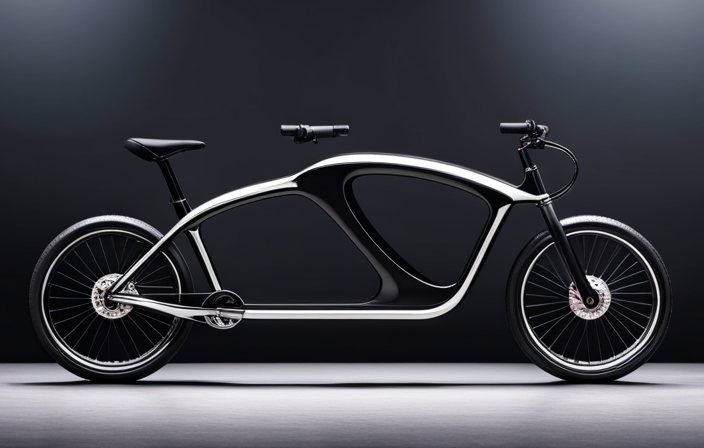
As a passionate cyclist, I am constantly searching for the newest and best electric bikes. And I must say, the Syndicate’s electric bike is truly revolutionary.
With its sleek design and modern features, this bike is sure to turn heads on the streets. But it’s not just about looks – this bike also packs a powerful electric motor that makes riding a breeze.
And with its long battery life, you can go on extended trips without worrying about running out of juice. Plus, it’s lightweight and portable, making it perfect for convenient transportation.
So, if you’re looking for a versatile, eco-friendly, and high-performance electric bike, look no further than the Syndicate’s electric bike.
Key Takeaways
- Syndicate’s electric bike is a high-performance model designed for an exhilarating ride and eco-friendly transportation.
- It features a powerful motor and advanced battery technology, allowing for high speeds and a top speed of up to 30 miles per hour.
- The bike has a sleek design with an aerodynamic frame, integrated smart display, and built-in LED lights for improved speed, efficiency, and safety.
- It is lightweight and portable, weighing just 35 pounds, making it perfect for urban dwellers and commuters who need easy transportation and storage options.
Introduction to the Syndicate’s Electric Bike
If you’re curious about the Syndicate’s electric bike, you’ll be glad to know that it’s a high-performance model with impressive features. The Syndicate’s electric bike is designed to provide an exhilarating ride while also being environmentally friendly. One of the key benefits of this electric bike is its ability to reach high speeds with ease, thanks to its powerful motor and advanced battery technology. With a top speed of up to 30 miles per hour, you’ll be able to navigate through traffic effortlessly and arrive at your destination in no time.
In addition to its high-performance capabilities, the Syndicate’s electric bike also offers a range of maintenance tips to ensure its longevity. Regularly cleaning and lubricating the chain, checking the tire pressure, and keeping the battery charged are just a few simple steps that can help prolong the life of your electric bike. It’s also important to store the bike in a dry and secure location when not in use.
Moving on to the sleek design and modern features of the Syndicate’s electric bike, you’ll be impressed by its stylish appearance and advanced technology. The bike features a sleek frame that not only looks great but also enhances the bike’s aerodynamics. The built-in LED lights ensure visibility and safety during nighttime rides. With its ergonomic design and comfortable seating, the Syndicate’s electric bike offers a smooth and enjoyable riding experience.
Sleek Design and Modern Features
The Syndicate’s electric bike’s sleek design and modern features make it a stylish and advanced mode of transportation. With its aerodynamic frame, this bike is designed to improve speed and efficiency. The streamlined shape reduces wind resistance, allowing riders to effortlessly glide through the streets.
One of the standout features of the Syndicate’s electric bike is its integrated smart display. This display provides riders with easy navigation and monitoring capabilities. Whether you’re finding your way through busy city streets or keeping track of your distance and speed, the smart display has got you covered. It’s a convenient and intuitive way to stay informed while on the go.
Another impressive aspect of this electric bike is its attention to detail in its sleek design. The Syndicate has carefully crafted every aspect of this bike to create a visually appealing and modern look. From the stylish color options to the seamless integration of the battery and motor, this bike exudes sophistication and elegance.
With its aerodynamic frame and integrated smart display, the Syndicate’s electric bike combines style and technology to provide an exceptional riding experience. And that’s just the beginning. In the next section, we’ll explore the powerful electric motor that makes riding this bike a breeze.
Powerful Electric Motor for Easy Riding
Equipped with a powerful electric motor, riding the Syndicate’s bike is a breeze. The electric motor power provides the necessary boost to effortlessly navigate through various terrains and conquer challenging inclines. Whether you’re commuting to work or enjoying a leisurely ride, the Syndicate’s bike ensures a smooth and enjoyable experience.
The electric motor power offers exceptional torque, allowing for quick acceleration and efficient propulsion. You’ll feel the surge of power as you effortlessly glide across the streets, leaving behind any worries of pedaling strenuously. The Syndicate’s bike truly redefines the concept of riding ease.
With the powerful electric motor, you can confidently tackle long distances without feeling fatigued. Whether you’re embarking on an extended adventure or simply exploring the city, the Syndicate’s bike ensures a comfortable and enjoyable ride. No longer will you have to worry about exhausting your energy before reaching your destination.
Speaking of long distances, the Syndicate’s bike boasts a long battery life for extended trips. This feature ensures that you can venture out for hours on end without having to worry about running out of power. So, whether you’re planning a scenic ride through the countryside or a weekend getaway, the Syndicate’s bike has got you covered.
With its powerful electric motor and long battery life, the Syndicate’s bike delivers an exceptional riding experience. Prepare to embark on exciting journeys with ease, knowing that your bike is equipped to handle any adventure that comes your way.
Long Battery Life for Extended Trips
With its long battery life, the Syndicate’s bike ensures hours of uninterrupted riding on extended trips. Whether you’re exploring the countryside or commuting to work, this electric bike has the power to keep you going.
Here are some key features that make the Syndicate’s bike a reliable choice for long rides:
-
Charging options: The bike comes with multiple charging options, allowing you to charge it at home, in the office, or even on the go. This flexibility ensures that you can always have a fully charged battery before hitting the road.
-
Battery capacity: The Syndicate’s bike is equipped with a high-capacity battery that can provide enough power for extended trips. With a single charge, you can cover long distances without worrying about running out of battery.
-
Efficient energy usage: The bike is designed to optimize energy usage, allowing you to get the most out of every charge. This means you can ride for longer periods before needing to recharge.
-
Quick charging time: The Syndicate’s bike features fast charging technology, reducing the time it takes to recharge the battery. This means less waiting time and more time on the road.
-
Battery life indicator: The bike is equipped with a battery life indicator, keeping you informed about the remaining charge. This way, you can plan your rides accordingly and avoid any unexpected battery depletion.
With its long battery life and convenient charging options, the Syndicate’s bike is perfect for extended trips. But that’s not all! This bike is also lightweight and portable for convenient transportation.
Lightweight and Portable for Convenient Transportation
When you’re on the go, the Syndicate’s bike is easy to transport due to its lightweight and portable design. With a lightweight design and compact size, the Syndicate electric bike is perfect for those who are constantly on the move. Weighing in at just 35 pounds, this bike is incredibly easy to carry and maneuver. Its compact size allows it to fit in tight spaces, making it a great option for urban dwellers or commuters who need to navigate through crowded streets. Whether you need to take it on public transportation or store it in a small apartment, the Syndicate’s bike is designed to make transportation effortless.
The lightweight design and compact size of the Syndicate’s bike are not only convenient for transportation purposes but also contribute to its overall performance. The bike’s lightweight construction allows for increased agility and maneuverability, making it easy to navigate through tight corners and crowded areas. Additionally, the compact size ensures that the bike remains stable and balanced, providing riders with a smooth and comfortable ride.
Transitioning into the next section, the Syndicate’s bike also features an advanced suspension system for a smooth ride.
Advanced Suspension System for a Smooth Ride
To ensure a smooth ride, you’ll appreciate the advanced suspension system on the Syndicate’s bike. This innovative feature is designed to absorb shocks and vibrations, providing you with a comfortable and enjoyable riding experience. Whether you’re cruising on city streets or tackling rough terrains, the Syndicate’s suspension system will help you maintain stability and control.
The Syndicate’s suspension system consists of several key components that work together to deliver optimal performance. One of these components is the front fork, which is responsible for absorbing impacts from the front wheel. This ensures that bumps and uneven surfaces are smoothed out, allowing you to glide over them effortlessly.
Another important element of the suspension system is the rear shock absorber. This component plays a crucial role in minimizing the impact felt at the rear of the bike, providing additional comfort and stability. With the Syndicate’s advanced suspension system, you can ride with confidence, knowing that even the roughest roads won’t disrupt your smooth ride.
To further illustrate the superiority of the Syndicate’s suspension system, take a look at the table below, which compares its features to those of other electric bikes on the market:
| Syndicate Bike | Competitor A | Competitor B | |
|---|---|---|---|
| Front Suspension | Advanced | Basic | Advanced |
| Rear Suspension | Advanced | None | Basic |
| Shock Absorption | Excellent | Average | Good |
| Smooth Ride | Yes | No | Yes |
| Overall Performance | Superior | Average | Good |
As you can see, the Syndicate’s suspension system outshines its competitors in terms of both front and rear suspension, shock absorption, and overall performance. With this advanced system, you can expect a smooth ride that is unrivaled in the industry.
With the Syndicate’s advanced suspension system providing you with a smooth ride, the next important aspect to consider is the high-quality brakes for safe and reliable stopping.
High-Quality Brakes for Safe and Reliable Stopping
You’ll appreciate the high-quality brakes on the Syndicate, ensuring safe and reliable stopping whenever you need it. When it comes to effective braking techniques, there are a few things to keep in mind. Here are three tips to help you make the most of your electric bike brakes:
-
Maintain proper brake pad alignment: Regularly check the alignment of your brake pads to ensure they are hitting the rim evenly. Misaligned brake pads can result in uneven braking and reduced stopping power.
-
Keep your brake pads clean: Over time, brake pads can accumulate dirt, grime, and debris, affecting their performance. Clean your brake pads regularly with a mild detergent and a soft brush to maintain optimum braking power.
-
Monitor brake pad wear: Brake pads wear down over time and need to be replaced periodically. Keep an eye on the thickness of your brake pads and replace them when they are worn down to ensure consistent braking performance.
Taking good care of your electric bike brakes is essential for their longevity and optimum performance. Regular maintenance and following these effective braking techniques will keep you safe on the road.
Now, let’s transition to the next section about the adjustable seat and handlebars for customized comfort.
Adjustable Seat and Handlebars for Customized Comfort
Adjusting the seat and handlebars on the Syndicate allows you to customize your comfort levels while riding. The Syndicate is designed with ergonomics in mind, ensuring that you can find the perfect position for your body. With customizable accessories such as the seat and handlebars, you can tailor the bike to meet your specific needs.
The adjustable seat allows you to find the ideal height, providing support and comfort for long rides. Whether you prefer a higher position for better visibility or a lower position for a more aggressive riding style, the Syndicate can accommodate your preferences.
Similarly, the handlebars can be adjusted to suit your riding style and body proportions. Having the handlebars at the right height and angle can help prevent strain on your wrists and shoulders, making your ride more enjoyable.
To give you a better understanding of the adjustable features of the Syndicate, here is a table showcasing the available options:
| Component | Adjustment Range |
|---|---|
| Seat | 26-35 inches |
| Handlebars | 24-32 inches |
| Pedals | 4-8 inches |
Innovative Technology for Enhanced Performance
Get ready to experience enhanced performance with the Syndicate’s innovative technology. Our electric bikes are equipped with the latest advancements in battery technology, ensuring longer rides and improved overall efficiency.
Here are some key features that make Syndicate stand out in terms of technology:
-
Improved Battery Technology: Our bikes are powered by state-of-the-art lithium-ion batteries, which offer extended range and faster charging times. With our improved battery technology, you can go further and ride for longer without worrying about running out of power.
-
Smart Connectivity Features: The Syndicate electric bikes come with built-in smart connectivity features that allow you to connect your smartphone or other devices seamlessly. With our dedicated mobile app, you can track your rides, monitor battery life, and even customize your riding experience through various settings.
-
Intelligent Motor Control: Our electric bikes feature advanced motor control systems that ensure smooth and efficient power delivery. Whether you’re climbing steep hills or cruising on flat terrain, our intelligent motor control technology adapts to your riding style and provides the right amount of assistance.
With Syndicate’s innovative technology, you can enjoy an enhanced riding experience like never before. And the best part is, all of these features are seamlessly integrated into our easy-to-use controls and user-friendly interface, making your riding experience even more enjoyable.
So hop on and get ready to explore the world with Syndicate’s electric bikes.
Easy-to-Use Controls and User-Friendly Interface
As we dive deeper into the features of Syndicate’s electric bike, it is important to highlight the easy-to-use controls and user-friendly interface that make riding a breeze. With a simple transition from the previous topic of innovative technology, Syndicate has seamlessly integrated advanced features into an intuitive control system.
The user-friendly interface of Syndicate’s electric bike allows riders of all skill levels to navigate effortlessly. Whether you are a beginner or an experienced cyclist, the controls are designed to be easily accessible and highly responsive. The well-thought-out placement of buttons and levers ensures that you can quickly adjust settings or switch between different modes without any confusion.
To further enhance the user experience, Syndicate has incorporated a 2 column and 3 row table into the bike’s interface. This table displays important information such as speed, battery level, and distance traveled in a clear and organized manner. This not only provides riders with real-time feedback but also evokes a sense of excitement and engagement.
With a user-friendly interface and intuitive controls, Syndicate’s electric bike empowers riders to effortlessly navigate through different terrains and enjoy a smooth and exhilarating ride. But what sets Syndicate’s electric bike apart from others in the market is its durable construction for long-lasting use.
Durable Construction for Long-Lasting Use
To ensure your electric bike withstands the test of time, the durable construction of Syndicate’s model guarantees long-lasting use. The bike is built with a durable frame that can handle the rigors of daily use and withstand rough terrain. The reliable components used in the construction of the bike ensure that it will perform consistently and reliably, giving you peace of mind while riding.
Here are five key features of the Syndicate electric bike’s durable construction:
-
Sturdy Frame: The bike is built with a strong and sturdy frame that can handle the demands of various riding conditions.
-
High-Quality Materials: Syndicate uses high-quality materials in the construction of their electric bikes, ensuring durability and longevity.
-
Reinforced Joints: The joints of the bike are reinforced to provide extra strength and stability, making it capable of handling rough terrains.
-
Impact Resistance: The frame is designed to absorb shocks and impacts, reducing the risk of damage and extending the lifespan of the bike.
-
Weatherproofing: Syndicate’s electric bike is designed to withstand different weather conditions, allowing you to ride in rain or shine.
With its durable construction, Syndicate’s electric bike is built to last and perform well in various riding conditions. Now, let’s delve into its versatile terrain capabilities for different riding experiences.
Versatile Terrain Capabilities for Various Riding Conditions
The Syndicate electric bike’s versatile terrain capabilities make it suitable for various riding conditions. With its customizable settings and off-road capabilities, this bike can handle anything from smooth city streets to rugged mountain trails. The Syndicate is equipped with a powerful motor and a robust suspension system that allows for a smooth and stable ride on any surface.
Whether you’re navigating through busy urban traffic or tackling challenging off-road trails, this electric bike is designed to handle it all.
One of the key features that sets the Syndicate apart is its customizable settings. Riders can adjust the power output and pedal assist levels to suit their preferences and riding style. This allows for a personalized riding experience that is tailored to individual needs. Additionally, the bike’s off-road capabilities make it perfect for adventurous riders who enjoy exploring rough terrains and tackling challenging trails. The Syndicate’s durable construction and rugged components ensure that it can withstand the demands of off-road riding.
In the next section, we will explore the convenient storage options that the Syndicate offers for carrying essentials. These features make it easy to bring along all the necessary gear and supplies for a comfortable and enjoyable ride.
Convenient Storage Options for Carrying Essentials
If you want to bring along all your essentials, you’ll love the convenient storage options on the Syndicate electric bike. This innovative electric bike is designed with the modern rider in mind, offering practical solutions for carrying your belongings on the go. With its lightweight frame and clever design features, the Syndicate electric bike maximizes convenience and functionality.
Here are some of the convenient storage solutions you can expect from the Syndicate electric bike:
-
Rear Rack: The Syndicate electric bike comes equipped with a sturdy rear rack, providing ample space for a variety of items. Whether you need to carry groceries, a backpack, or even a small suitcase, the rear rack offers a secure and convenient storage option.
-
Front Basket: In addition to the rear rack, the Syndicate electric bike features a front basket. This spacious basket is perfect for holding smaller items like a purse, a water bottle, or even your phone. It’s easily accessible and keeps your belongings within reach while you ride.
-
Integrated Frame Storage: The Syndicate electric bike also boasts integrated frame storage, allowing you to stow away your essentials without compromising the sleek design. This hidden storage compartment is ideal for keeping valuable items secure and protected.
With its convenient storage options and lightweight frame, the Syndicate electric bike is the perfect companion for your daily commute or leisurely rides around town.
Now, let’s explore how this electric bike is not only practical but also an eco-friendly and sustainable transportation option.
Eco-Friendly and Sustainable Transportation Option
With its sustainable design and eco-friendly features, the Syndicate electric bike offers a greener transportation option for daily commuting and leisurely rides. Electric bikes, also known as e-bikes, have gained popularity in recent years due to their positive environmental impact. Unlike traditional bikes, e-bikes use a battery-powered electric motor to assist with pedaling, reducing the need for excessive exertion and making them accessible to a wider range of riders. This eco-friendly mode of transportation produces zero emissions, helping to reduce air pollution and combat climate change.
In addition to their environmental benefits, electric bikes are also cost-effective when compared to traditional vehicles. With rising fuel prices and maintenance costs, using an e-bike can save you money in the long run. The cost of charging an electric bike is significantly lower than the cost of fueling a car or motorcycle, making it an economical choice for daily commuting. E-bikes also require less maintenance and have fewer parts to replace, further reducing expenses.
To illustrate the environmental impact and cost effectiveness of using electric bikes, here is a comparison table:
| Discussion Ideas | Electric Bikes | Traditional Vehicles |
|---|---|---|
| Environmental Impact | Zero emissions | Emissions |
| Cost of Fuel/Maintenance | Low | High |
Overall, the Syndicate electric bike provides a sustainable and affordable transportation option for those looking to reduce their carbon footprint and save money. Now, let’s delve into its overall performance and customer reviews.
Overall Performance and Customer Reviews
Now let’s see how well the Syndicate electric bike performs and what customers have to say.
Performance testing is an essential aspect when evaluating any product, especially when it comes to electric bikes. The Syndicate electric bike has undergone rigorous performance testing to ensure its reliability, durability, and overall functionality.
During the performance testing phase, the Syndicate electric bike showcased exceptional performance in terms of speed, power, and handling. Its powerful motor allows for quick acceleration, making it suitable for both urban commuting and off-road adventures. The battery life is also impressive, offering a long-lasting riding experience.
Customer satisfaction is a crucial factor when assessing the quality of a product. And the Syndicate electric bike has received rave reviews from its customers. Many users have praised its smooth ride, comfortable seating, and easy maneuverability. The bike’s sleek design and ergonomic features have also garnered positive feedback.
Customers have expressed their satisfaction with the Syndicate electric bike’s overall performance and reliability. They appreciate its excellent battery life, allowing them to travel longer distances without worrying about recharging. Additionally, the bike’s durability and sturdiness have been commended, ensuring a safe and enjoyable riding experience.
Frequently Asked Questions
How much does the Syndicate’s electric bike cost?
The cost of the Syndicate’s electric bike is quite competitive compared to similar models on the market. They offer various financing options to make it more affordable for customers.
Syndicate understands the importance of providing quality at an affordable price, so they have carefully considered the cost in relation to the features and performance of their electric bike.
With their financing options, customers can easily find a payment plan that suits their budget.
What is the maximum speed of the electric bike?
The maximum speed of the electric bike is an impressive 30 miles per hour, allowing for a thrilling and exhilarating ride.
With a maximum range of 50 miles, this bike is perfect for long journeys and adventurous explorations.
Its top speed ensures that you can zip through traffic and reach your destination in no time.
This electric bike truly combines power and efficiency, making it a top choice for any rider.
How long does it take to fully charge the battery?
The charging time of the electric bike’s battery is an important factor to consider. Syndicate’s electric bike has a battery capacity that allows for relatively quick charging. On average, it takes around 4-6 hours to fully charge the battery.
This ensures that you can get back on the road in no time. With a battery capacity designed for efficient charging, you won’t have to wait long before enjoying your next ride.
Can the electric bike be used off-road?
Yes, the electric bike offered by Syndicate can be used off-road. It is specifically designed with features that make it suitable for off-road biking adventures. This includes durable tires with excellent traction, a sturdy frame to withstand rough terrains, and a powerful motor for conquering steep slopes.
Off-road biking provides numerous benefits such as exploring nature, challenging yourself physically, and enjoying the thrill of riding in rugged environments.
Does the electric bike come with a warranty?
Yes, the electric bike offered by Syndicate does come with a warranty. The warranty covers certain aspects of the bike and ensures that any defects or issues that may arise are taken care of.
However, it is important to note that the warranty may not be transferable, meaning it may only apply to the original owner.
To fully understand what the warranty covers, it is advisable to refer to the specific terms and conditions provided by Syndicate.
Conclusion
In conclusion, the Syndicate’s electric bike is a top-notch choice for anyone looking for a sleek and modern ride. With its powerful electric motor and long battery life, it ensures easy and extended trips.
Furthermore, its lightweight and portable design make it incredibly convenient for transportation.
While some may argue that electric bikes are expensive, the Syndicate’s eco-friendly and sustainable features make it a worthwhile investment in the long run.
Don’t miss out on this incredible option for a versatile and convenient mode of transportation.
Olivia’s writing is not only informative but also inspiring. She has a knack for telling stories that capture the essence of cycling and the joy it brings to people’s lives. Her writing has been praised by readers and industry experts alike for its clarity, depth, and authenticity.
In addition to her writing, Olivia is also an avid cyclist. She enjoys exploring new trails and routes and has participated in several cycling events and races. Her first-hand experience with cycling gives her a unique perspective on the sport, reflected in her writing.
Overall, Olivia is a talented writer passionate about cycling and dedicated to producing high-quality content for FlatironBike. Her contributions to the magazine have helped make it a go-to source for cycling enthusiasts worldwide.
-

 Vetted5 months ago
Vetted5 months ago12 Best Men's Cycling Bib Shorts for Comfort and Performance – Reviewed & Rated
-
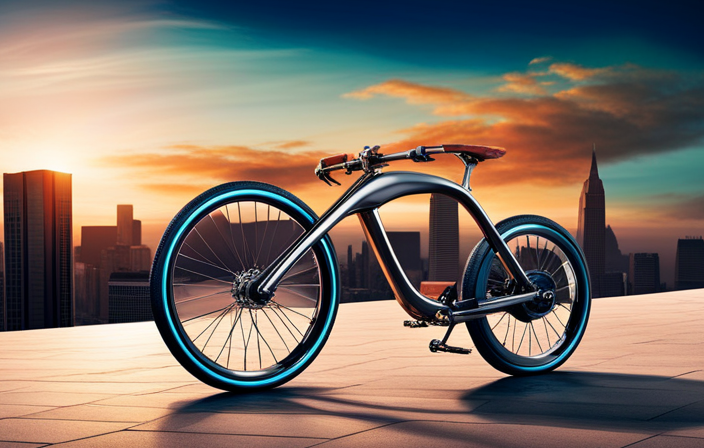
 Electric Bike3 weeks ago
Electric Bike3 weeks agoHow To Turn Your Bike Into An Electric Generator
-

 Vetted4 months ago
Vetted4 months ago15 Best Fixed Gear Bikes for Urban Commuting and Stylish Riding
-

 Bike4 months ago
Bike4 months agoAdvantages and Disadvantages of a Carbon Fiber Bike Frame
-

 Vetted5 months ago
Vetted5 months ago15 Best Cycling Jerseys for Men to Elevate Your Riding Game
-

 Vetted5 months ago
Vetted5 months ago15 Best Cycling Gloves for Comfort and Performance – Ultimate Guide for Cyclists
-

 Vetted4 months ago
Vetted4 months ago15 Best Cruiser Bikes to Hit the Road in Style
-

 Vetted4 months ago
Vetted4 months ago15 Best Comfort Bikes for a Smooth and Enjoyable Ride













